-
TrackoBit
Manage commercial vehicles with the new-age Fleet Management Software
TrackoBit -
TrackoField
Streamline your scattered workforce with Field Force Management Software
TrackoField -
Features Resources
-
Blog
Carefully curated articles to update you on industrial trends. -
White Paper
Insightful papers and analysis on essential subject matters. -
Glossary
Explore an alphabetical list of relevant industry terms. -
What’s New
Get TrackoBit & TrackoField monthly updates here. -
Case Study
Explore the cases we solved with our diverse solutions. -
Comparisons
Compare platforms, features, and pricing to find your best fit.
-
About Us
Get to know TrackoBit: our team, ethos, values, and vision. -
Careers
Join the most dynamic cult of coders, creatives and changemakers. -
Tech Support
Learn about our technical support team and services in detail. -
Events
Check out the exhibitions where we left our marks and conquered. -
Contact Us
Connect with us and let us know how we can be of service.
Top 6 Ways Of Improving Last-Mile Delivery with Analytics
- Author:Tithi Agarwal
- Read Time:9 min
- Published:
- Last Update: December 9, 2025
Table of Contents
Toggle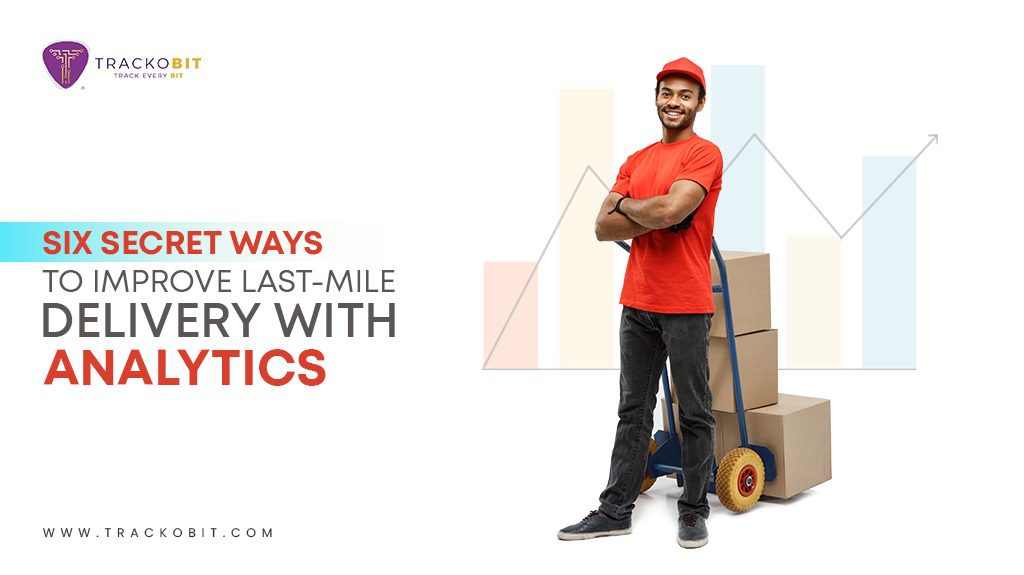
Improve your last mile delivery operations by channelising the power of insights and analytics that, without a doubt, will have a massive impact on your business.
Table of Contents
Toggle
Data is an influential tool in today’s world. There is hardly any business that does not want to leverage the power of the right data at the right time. Improving Last-mile delivery with analytics, too, can channelise the prowess of metrics that will result in an improved delivery process. This will undoubtedly amp up your chances of acquiring loyal customers and retailers depending on your services to transport goods from one place to another.
Only through proper data can you identify – that the last mile alone consumes 53% of the budget of the supply chain.
And 70% of consumers want friendly and convenient delivery services. With easy analytics, you can improve the cost of last-mile operations, which is one of the significant challenges.
What is Last Mile Analytics?
Last mile analytics refers to collecting, analyzing, and interpreting the data related to the final step in the delivery process. The data can be gathered from the distribution centre to the end consumers. Its main motive is to optimise and smoothen the delivery process and improve customer experience.
These last-mile analytics are applicable across industries that deliver goods and services like e-commerce, logistics, healthcare, and retail. These analytics, when utilised, can result in enhanced efficiency, cost reduction, and delivering on customer expectations.
Analytics is not just another fancy term. Instead, it is a force strong enough to turn your operations around. But before we jump into last-mile delivery analytics, let’s dissect and understand the anatomy of analytics.
The Anatomy of Analytics
Analytics or data analytics lets you examine data, enabling you to answer questions and identify trends and consumer demand patterns. All this gets done by burrowing out valuable insights.
Descriptive Analytics⬇️
Descriptive analytics is the very first step towards mining the raw data. It will allow you to identify trends and, when delved in deeper, it can help you answer the question,” what happened?”
For example, recently, there has been a surge of failed deliveries in a certain area where mostly working employees live. But due to heavy traffic and unleveled roads, your delivery agents take too long to deliver the parcel. Thus missing out on the short delivery window.
The descriptive analytics will tell you about the increase in a failed delivery and that the employees are facing congested routes.
Diagnostics Analysis⬇️
Diagnostics analysis will help you answer the question, “ why is this happening?”
This type of analysis generally compares two coexisting data or trends and unearths correlations between the two variables.
Continuing with the aforementioned example, managers might find a trend that the road assigned to the employees has an office rush from 8 am – 12 pm. And that is also not the most optimised or suitable route for early deliveries. Hence, the delivery agents are missing out on the delivery window.
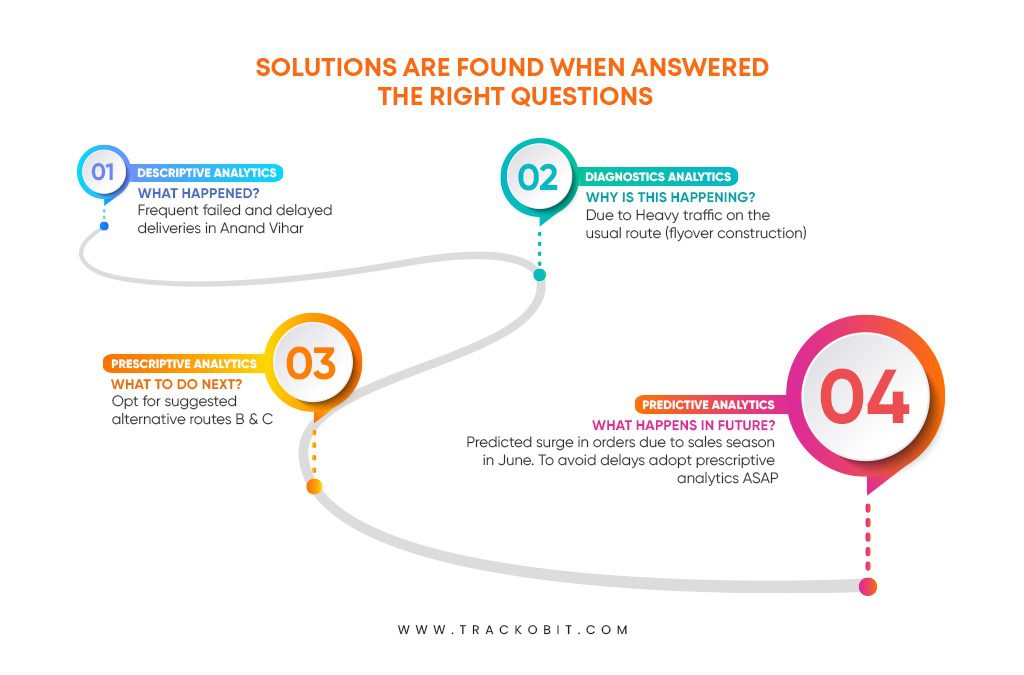
Prescriptive Analytics ⬇️
Prescriptive analytics will answer the question, “ what to do next?”
This sort of analysis will suggest answers after considering multiple factors and actions that could be taken. It is useful when making data-based decisions.
Continuing with the example: According to the prescriptive analysis, your managers ought to assign such deliveries to employees well versed in manoeuvring heavy traffic and driving expertly on unleveled roads. The data from the system would suggest drivers and offer alternative and optimised routes.
Predictive Analytics
Predictive Analysis will answer the question, “ what might happen in the future?”
By analysing the past stored data and trends from the system, managers will be able to make well-analysed predictions for your company.
For instance, with the gifting season nearing, orders are bound to increase, and the company cannot afford so many failed deliveries daily. The system will predict an upcoming increase in orders that must be delivered in the forthcoming. Hence the company should adopt preventive measures the earliest.
These analytics can be easily, automatically viewed and implemented through last-mile delivery software.
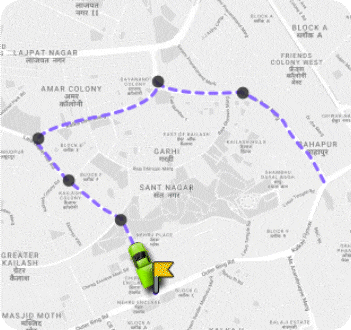
Last Mile Delivery Software
Have everything done within second: order sorting, route optimisation, and dispatch planning.
Dont’t believe us?
The Breakup of Last Mile Delivery Analytics Offered by Last Mile Delivery Software
The last mile delivery software like TrackoMile can be an excellent choice if you want to automate the process of extracting, processing, and analysing raw data. Not only this, but the software even presents analytics in a visual representation like charts and graphs for a better understanding and ease of visualisation.
Dashboard Analytics
The software’s dashboard is such that you get the key analytics right in front of you. You don’t have to dig deep. Analytics aiding with route optimisation and delivery allocation to the best-suited personnel can be viewed upfront. Also, a full detailed view of the employee’s activity is on display on the dashboard.
Locational Analytics
Locational analytics is about garnering and analysing geospatial and other locational data. The system will help you analyse the data into business insights and also help you to execute it. The software will present you with such data to leverage in real time.
This also contains data on incidents your riders might be facing in a particular area frequently, like theft or delivery delays. For example, certain food delivery companies might reject orders from certain areas late at night due to theft.
Performance Analysis
It is vital for companies dealing with last mile deliveries to audit their employees’ performance frequently. The reason being customer satisfaction, cost of operations, and reason for failed deliveries depends on them. The last mile delivery technology will help you conduct audits by providing real time insights into the riders’ performance.
Analytical Reports
Get conclusive insights and analytics in bite-size auto-generated real-time reports. The reports contain data and metrics on the latest trends, what is going wrong in the delivery procedure, and how to rectify it. These analytical reports can be helpful when it’s time to take decisions.
Read More – Ways to Make Fleet Management Efficient
How Are These Analytics Improving Last Mile Delivery
Relying on the last mile delivery software to improve your delivery process is a smart choice. The software will utilise big data to optimise operations concerning customers, routes, and cost reduction. It lets you hop on to the latest trends through predictive analysis. This is essential if you want to stay ahead of the curve.
Stop Sequencing and Route Optimisation
Optimisation and automation are essential tools that use analytical insights. For example, the analytics might show that a specific order must be reached the earliest, but another delivery is in the way. The software would suggest the shortest route and effective stop sequencing, allowing the rider to deliver orders the earliest and in one go. This way, the rider won’t be zip-zapping throughout the city.
Driver Scheduling Issues
The system has all the necessary data required to form a foolproof delivery plan. And because of the combination of data and automation, the software automatically assigns deliveries to the most suited and available riders.
Improve Delivery Agent Behaviour
Riders are an essential aspect of the operations as they do the job. Therefore it becomes all the more vital to provide them with the appropriate information and tools to perform well. That is where analytics comes in.
Since the system provides data on the bottom line and can recognise real time patterns, the software will raise the alarm on prevalent issues the riders might be facing. Furthermore, the analytics will help the riders have a better-planned route and proper sequence planning. This will help to minimise idling.
Leveraging Historical Data for Better Delivery Plans
A solid delivery plan is vital when it comes to delivering orders within the promised delivery window. The accumulated data can be leveraged to prevent the company from assigning the same old battered routes to the drivers.
The proper usage of analytics can help companies form proper delivery structures for rural and urban areas.
Harness Technology to Master the Scale
As the demand and your operations grow, staying informed of every delivery step can be difficult. Mainly because what worked before might not work now. With a growing company comes the challenge of ensuring on-time delivery. This is because you are not able to monitor operations personally. This might lead to delayed deliveries, poor management, overworked employees, and dissatisfied customers.
You might uncover patterns and shifting perspectives through proper visual analytics to help you organise your delivery dispatch method. Additionally, predictive analytics is useful for identifying underlying issues in real time. For example, it will help detect riders who might need assistance.
Improve Communication with Drivers
Keeping drivers in the loop can help in deflecting potential delays. Through proper analytics, managers can communicate information on delivery route changes and traffic conditions well in advance.
Poor driver communication also affects their retention. Flawed communication can cause them to be unhappy and might start looking for another job.
Last Mile Delivery Analytics – Usecase
An excellent example of using analytics to improve your last-mile delivery operations is through gamification. Gamification is applying gaming principles to a non-gaming context. Last mile delivery software like TrackoMile is an excellent choice for this.
Gamification utilises analytical data to help you smoothen out the wrinkles in your delivery method in a very game-like manner. This method will ensure that your drivers deliver orders on time, thus automating the learning and improvement process.
TrackoMile’s analytical dashboard and leaderboard signify which driver is at the top of the game and hold the chance of winning. The gifts could be bonuses or merchandise. The leaderboard will display which rider follows all the KPIs while delivering orders. Failed deliveries can be curbed by gamifing the process.
This helps to cultivate an environment that is embracing and comfortable with analytics.
Leverage Analytical Insights with TrackoMile
There is no denying that analytics is a catalyst for achieving a much smoother and optimised last mile delivery. Let analytics be the reason why you are making all the right decisions. And since you easily access these metrics and insights through last-mile delivery software, it leaves no reason not to invest in one.
TrackoMile is the perfect choice because it offers real-time analytics, and analytical features like dashboards and reports are completely customisable. They can be altered to suit your requirements. This helps you scale your business further with the help of useful insights.
Last Mile Delivery Software
Have everything done within second: order sorting, route optimisation, and dispatch planning.
Dont’t believe us?
Tithi Agarwal is an established content marketing specialist with years of experience in Telematics and the SaaS domain. With a strong background in literature and industrial expertise in technical wr... Read More
Related Blogs
-
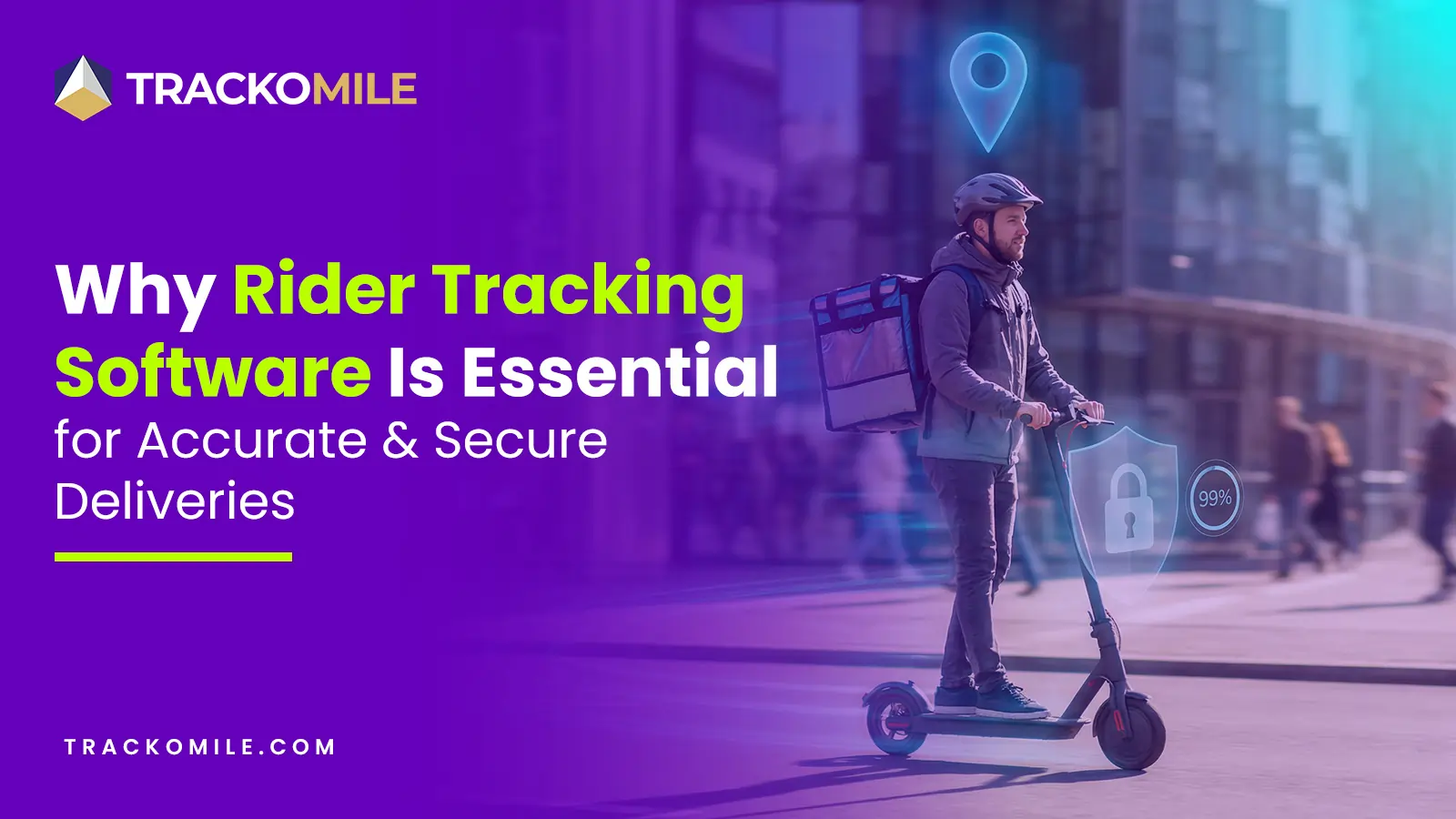
How Rider Tracking Software Improves Delivery Accuracy and Reduces Fraud
Tithi Agarwal December 8, 2025Rider tracking software improves delivery accuracy with real-time GPS visibility and automated ePOD. It also enables route optimisation and fraud…
-
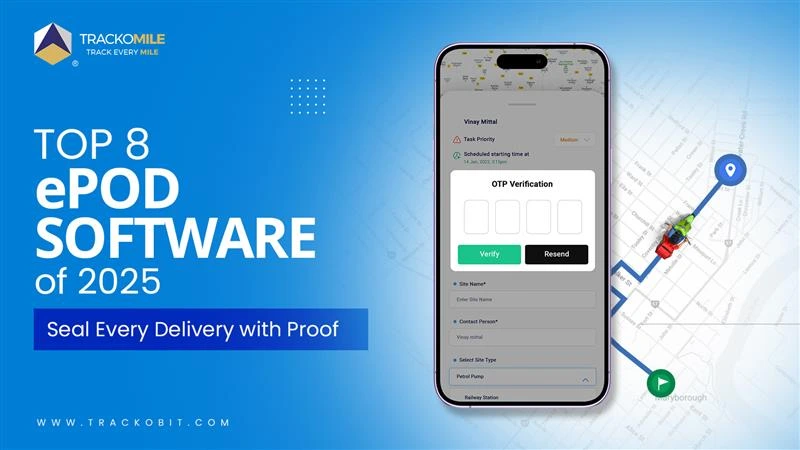
Top Electronic Proof of Delivery (ePOD) Software in 2025
Tithi Agarwal September 25, 2025Electronic proof of delivery has become the backbone of modern logistics. Explore the top 8 ePOD software in 2025 and…
-
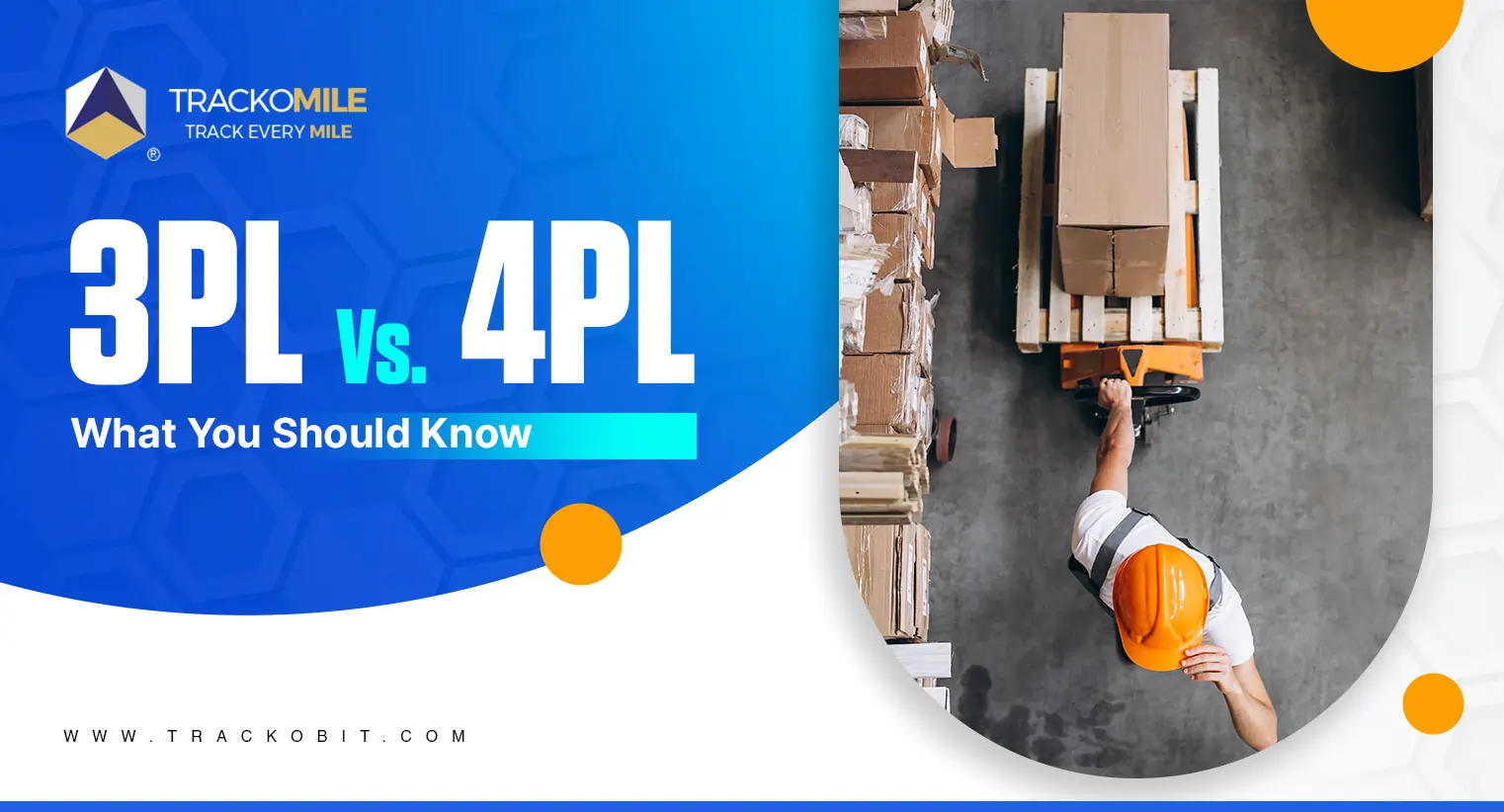
3PL vs. 4PL: Which is Best for Your Business?
Tithi Agarwal September 25, 2024Confused about choosing between 3PL and 4PL for your retail supply chain? Read this blog to find out which is…
-
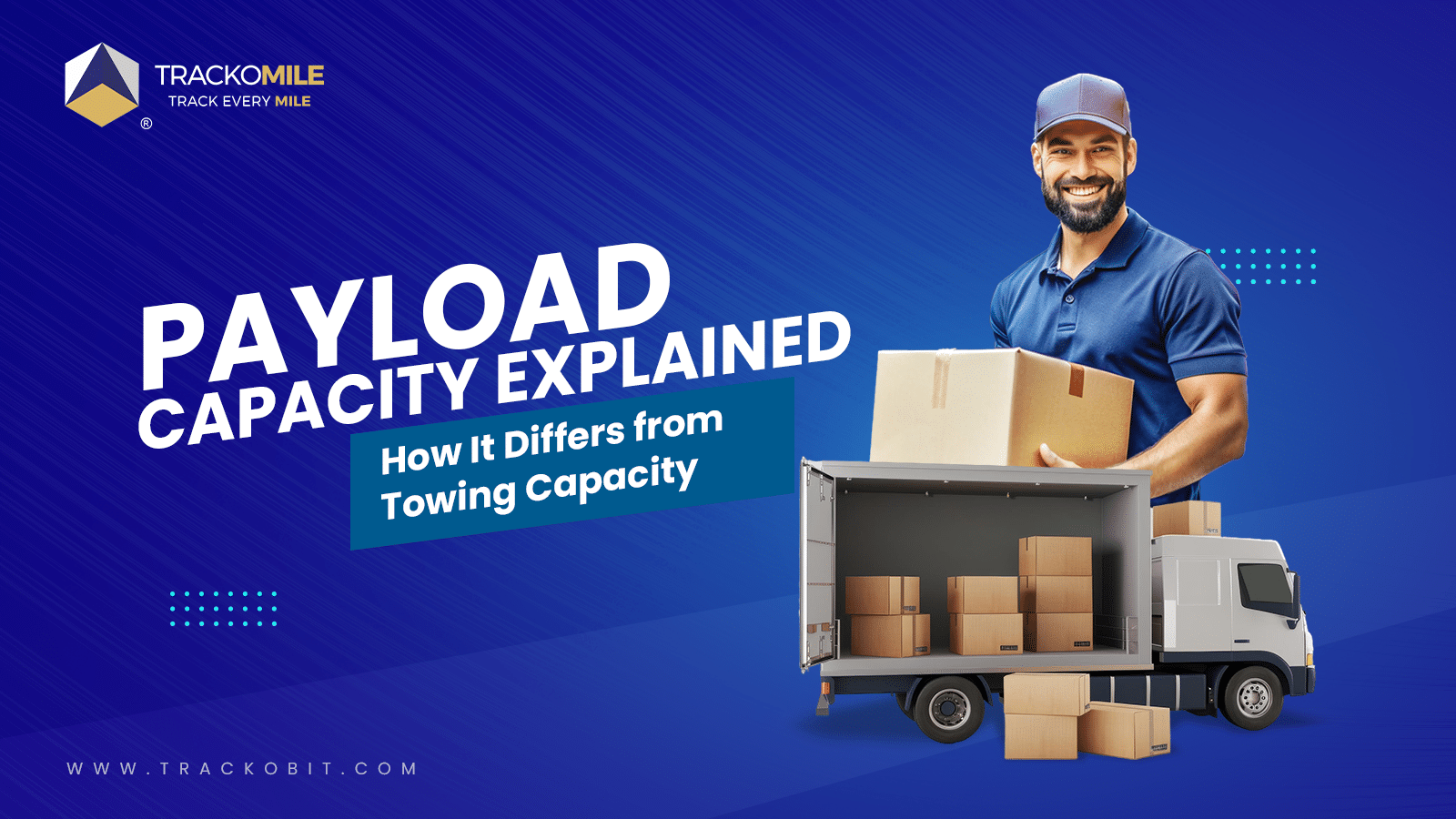
What is Payload Capacity? Payload Capacity Vs. Towing Capacity
Tithi Agarwal September 10, 2024Payload capacity is the total weight a vehicle can safely carry, and it is crucial for safety and compliance. Exceeding…

Subscribe for weekly tips to supercharge your last-mile delivery.
Your inbox awaits a welcome email. Stay tuned for the latest blog updates & expert insights.
"While you're here, dive into some more reads or grab quick bites from our social platforms!"Stay Updated on tech, telematics and mobility. Don't miss out on the latest in the industry.
We use cookies to enhance and personalize your browsing experience. By continuing to use our website, you agree to our Privacy Policy.


































